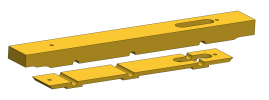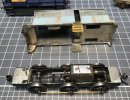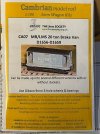BetweenTheTunnels
Active Member
Hmm, i seem to be right out of vampires blood at the moment!! I'll go with tinning it and see what happens! Thanks Simon!
Richie
Richie
Try using Garryflex blocks to clean the brass & remove excess solder. Garryflex blocks - Google SearchWell an hour or so working on the Gresley etches last night ended up being a total waste of time! My own fault really, getting to grips with the new soldering iron (See my journey in 3mm thread) and trying to solder the door vents onto the main bodyside etch. I ended up with too much solder on, then the vents wouldnt laminate with the main etch.
I concluded that lack of heat with was the problem, despite the new iron being an Antex 50W and set to 450 degrees - I think the default bit that came with the iron is only a 2.3mm bit, and am still waiting on a 6mm bit, the largest Antex do, arriving in the post. I think that should help the issue, and suspect the brass is acting as a heat sink against the a glass craft board and the current bit isnt big enough to heat the brass sufficiently. Ah well, another part of the learning curve, and of course as is typical with me, I chose one of the harder coach types to start with!
Richie
Thanks, yes i've got a Garryflex 240 block, but hadnt realised it could remove excess solder. I use it for cleaning the etches, but i'll have a go with that later or tomorrow! Thank youTry using Garryflex blocks to clean the brass & remove excess solder. Garryflex blocks - Google Search



Don’t do it. A milled chassis can be made to work and could be fun if you have the urge to use a milling machine but it is not the best way. It is the sort of thing recommended by Ahern in 1948 but is less likely to result in a smoothly running loco. I suggest reading post 1980 books or magazine articles about scale thickness frames and three point compensation, using the coupling rods to set the wheelbase. Easy to build with no machine tools and works reliably. Especially for 14.2mm finescale. You don’t need extra weight with a white metal body. Compensation improves pickup and traction.tell me I am going about it the wrong way and be constructive as to the way forward...

It's something I've seen a few times, although predominately with 2mmFS where weight is essential.But does anyone have any thoughts? Is the whole thing a bad idea, or has it been done before? I am assuming I am not trailblazing a new path here, although I haven't seen many (if any) other milled chassis?
As mentioned there quite a few 2mmFS models with milled chassis, I guess 3mm scale is on that cusp between 2mmFS where the weight is essential and 4mm scale and above. To some extent it may depend on whether DCC and stay alive is used, I suspect a milled chassis with DCC and stay alive will give a smooth running loco.Don’t do it. A milled chassis can be made to work and could be fun if you have the urge to use a milling machine but it is not the best way. It is the sort of thing recommended by Ahern in 1948 but is less likely to result in a smoothly running loco.
 I am definitely of the thought that some form of compensation needs to be included. I have not yet decided on a control scenario - I have used DCC in the past but to be honest, recently I worked a friends DC powered layout and it was really nice to get back to basics! So for now I am working on the DC route, and if it becomes DCC then nothing is lost. I take all the comments onboard that you've made tho.
I am definitely of the thought that some form of compensation needs to be included. I have not yet decided on a control scenario - I have used DCC in the past but to be honest, recently I worked a friends DC powered layout and it was really nice to get back to basics! So for now I am working on the DC route, and if it becomes DCC then nothing is lost. I take all the comments onboard that you've made tho.Phosphor bronze?
The wire from Cambrian comes nice and straight. I've a stock of coiled wire that I can't get straight at all...Thanks Simon, thats what I was thinking of! Just couldn't remember what it was called.

Thanks Paul, thats useful to know. I am assuming at 0.35mm would be ok for pick-ups? Or is it one of these things that the thicker the more springy it is and 0.5mm would be the better option?The wire from Cambrian comes nice and straight. I've a stock of coiled wire that I can't get straight at all...

Phosphor Bronze Wire
Straight Phosphor Bronze wire in 250cm lengths in various diameters.www.cambrianmodelrail.co.uk
Richie, I'd suggest 0.35mm for your application. Thanks for documenting your progress!Thanks Paul, thats useful to know. I am assuming at 0.35mm would be ok for pick-ups? Or is it one of these things that the thicker the more springy it is and 0.5mm would be the better option?
Thanks also for flagging Cambrian up Paul, I hadn't realised they did a 3mm wagon kit - and as this picture :
shows one of the LMS D1656 fitted vans still operating in 1963 (my layout will be 1957/1958) I may well order one of those at the same time!! Cheers!
Richie
 and if its the latter further proof that if you mess it you, you can work out a way to get it back right again ... he says hopefully!
and if its the latter further proof that if you mess it you, you can work out a way to get it back right again ... he says hopefully!
